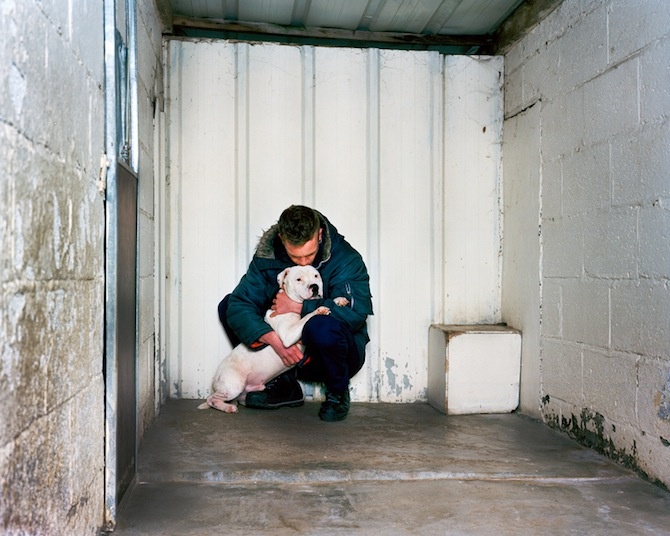
Niall Lester with Dru in the room where he was found after being abandoned
If you don't have a soft spot for abandoned dogs, you're a monster. There's something supremely shitty about adopting a dog – toddlers with four legs and a better appetite, essentially – just to abandon it in an industrial site or a park or by a motorway when you realise you haven't got yourself together enough to look after it properly.
When and if these dogs are picked up by animal services, they have a week or two to be claimed or picked up by a shelter before they're destroyed. Niall Lester works as an animal welfare officer for Dartford council and makes it his mission through his New Hope Animal Rescue charity to save as many of these "death row dogs" from euthanasia as possible, housing some of them in his own home.
Photographer Georgie Mason has been documenting Niall and the dogs he saves for months, so I caught up with her to talk about the saviour of South East London's purposefully lost dogs.
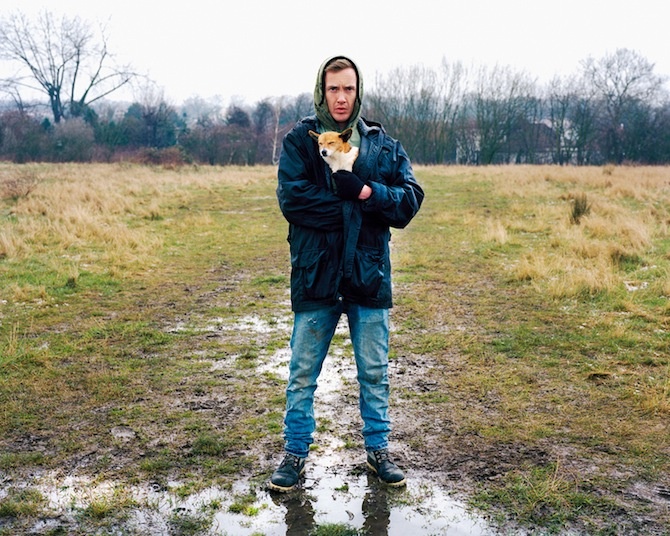
Niall with Tyson
VICE: Hi Georgie. How did you become involved in Niall's work?
Georgie Mason: I met him last year after I photographed him for another project, which was based on the relationship between people and their dogs. I was immediately drawn to Niall’s personality, passion and overall hectic life, and desperately wanted to explore more about him and his work. I then decided to base my final major project at university last year on Niall and the issue with dog abandonment.
Georgie Mason: I met him last year after I photographed him for another project, which was based on the relationship between people and their dogs. I was immediately drawn to Niall’s personality, passion and overall hectic life, and desperately wanted to explore more about him and his work. I then decided to base my final major project at university last year on Niall and the issue with dog abandonment.
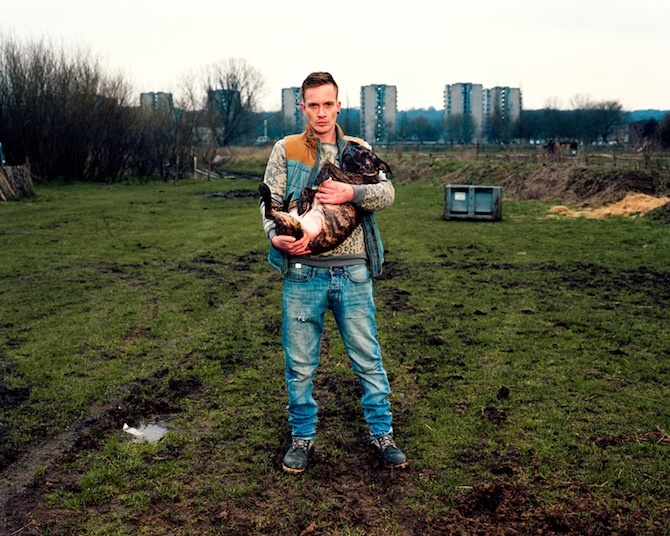
Niall with Marsha the Staffordshire Bull Terrier
Are you aware of how any of the dogs ended up being abandoned?
All the photographs in the series so far are based on the stories of the dogs' lives beforehand. For instance, the third photo in the series tells the story of a Staffordshire Bull Terrier, Marsha, who was living feral on the Erith Marshes in South East London for ten months after she was abandoned, before Niall rescued her in the summer of 2012. We then went back to the marshes to take this photograph.
All the photographs in the series so far are based on the stories of the dogs' lives beforehand. For instance, the third photo in the series tells the story of a Staffordshire Bull Terrier, Marsha, who was living feral on the Erith Marshes in South East London for ten months after she was abandoned, before Niall rescued her in the summer of 2012. We then went back to the marshes to take this photograph.
The last shot in the series was taken in a vet’s room to revisit the place where a Staffy cross named Blaze was due to be put to sleep. She was taken into the vets by her owner, who no longer wanted her after she went blind as a puppy. She was then on death row, and, just before her time was up, Niall rescued her from that vet’s room, minutes before euthanasia. Each of the photographs in the work are based on going back to the spots of rescue, so each of them have a different story to tell about why, where and how that dog was abandoned.
Is the series also supposed to be a statement about killing dogs if no one claims or re-homes them?
I’d say it definitely highlights that issue too, yeah. That's particularly evident in the last shot I talked about, given that Blaze was minutes away from being destroyed before Niall got to her. As with the other dogs photographed, had Niall not rescued them – or without the intervention of another rescue out there – they would very likely have been put down when in the hands of a local pound.
I’d say it definitely highlights that issue too, yeah. That's particularly evident in the last shot I talked about, given that Blaze was minutes away from being destroyed before Niall got to her. As with the other dogs photographed, had Niall not rescued them – or without the intervention of another rescue out there – they would very likely have been put down when in the hands of a local pound.
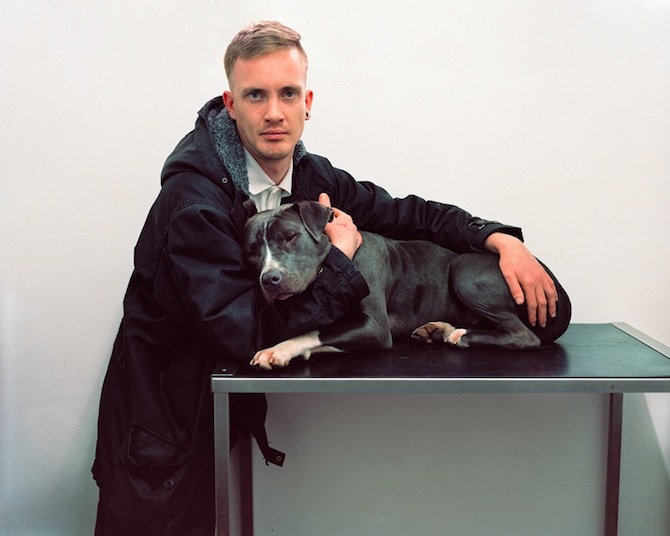
Niall with Blaze
How long do these dogs have to live once it's been decided that they are to be put down?
Most often one week, and in some lucky cases up to two weeks. After this time, if they haven’t been claimed or taken in by a rescue then they’ll be destroyed. Niall’s work essentially takes any abandoned dogs out of immediate danger, avoiding them going to pounds altogether.
Most often one week, and in some lucky cases up to two weeks. After this time, if they haven’t been claimed or taken in by a rescue then they’ll be destroyed. Niall’s work essentially takes any abandoned dogs out of immediate danger, avoiding them going to pounds altogether.
If it comes down to it, how are they put down?
By a lethal injection, intravenously.
By a lethal injection, intravenously.
Did you notice any breeds that were abandoned more than others?
As generalised as it may seem to say, all of these dogs ended up in these positions due to people: the owners, who fundamentally don’t get dogs for the right reasons. Many of these types of owners are unfortunately a product of the huge problem with "status symbol" dogs, which is why around 70 percent of dogs in pounds and rescue are bull-breed dogs, such as Staffies. As Niall has pointed out many times before, if labradors were the go-to dog for the types of people who own Staffies, there would be a huge labrador epidemic and the same vicious cycle would continue.
As generalised as it may seem to say, all of these dogs ended up in these positions due to people: the owners, who fundamentally don’t get dogs for the right reasons. Many of these types of owners are unfortunately a product of the huge problem with "status symbol" dogs, which is why around 70 percent of dogs in pounds and rescue are bull-breed dogs, such as Staffies. As Niall has pointed out many times before, if labradors were the go-to dog for the types of people who own Staffies, there would be a huge labrador epidemic and the same vicious cycle would continue.
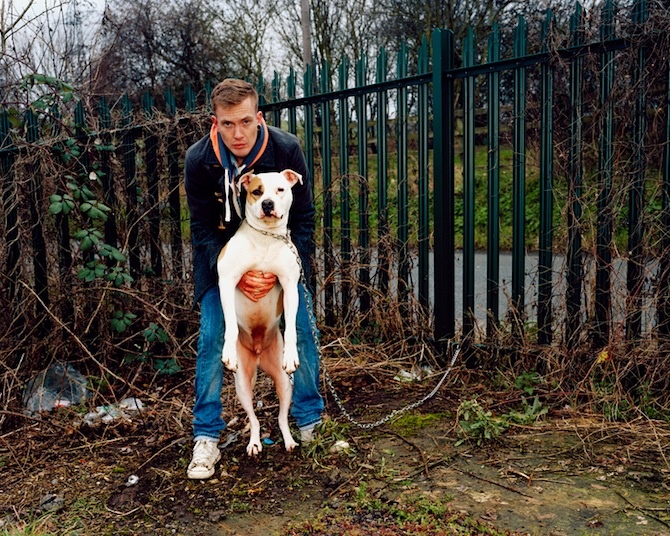
Niall with Phoenix
Do you think dogs should end up on "death row" if they have acted dangerously?
I don’t agree with it. I think by doing this it just avoids the root cause of the issue altogether. The fact that there are so many dogs who are not properly looked after, or even trained, which then might lead to this type of behaviour, is quite shocking. There need to be regulations as to who can own a dog, and they need training and a basic education on dog behaviour. If more people truly understood the breed of dog they owned – and provided enough exercise, discipline, socialisation and affection – there should be no reason why a dog would submit to aggressive behaviour. But instead, the easy option is to destroy that dog and blame the breed.
I don’t agree with it. I think by doing this it just avoids the root cause of the issue altogether. The fact that there are so many dogs who are not properly looked after, or even trained, which then might lead to this type of behaviour, is quite shocking. There need to be regulations as to who can own a dog, and they need training and a basic education on dog behaviour. If more people truly understood the breed of dog they owned – and provided enough exercise, discipline, socialisation and affection – there should be no reason why a dog would submit to aggressive behaviour. But instead, the easy option is to destroy that dog and blame the breed.
Where are you planning on taking this work?
I plan on continuing the project with Niall, to create a big collection of images that will be made into a book, with Niall being the consistent subject in the photos, but the dog, story and location changing each time. I also have another project that I’ve started planning for this year, based on exempt pitbull or "type" breeds and their owners, who have had their dogs seized from them due to the Dangerous Dog Legislation in the UK. Some of these owners have never had their dog returned to the family after they were destroyed, due to their breed alone.
I plan on continuing the project with Niall, to create a big collection of images that will be made into a book, with Niall being the consistent subject in the photos, but the dog, story and location changing each time. I also have another project that I’ve started planning for this year, based on exempt pitbull or "type" breeds and their owners, who have had their dogs seized from them due to the Dangerous Dog Legislation in the UK. Some of these owners have never had their dog returned to the family after they were destroyed, due to their breed alone.
Follow Chris on Twitter: @CBethell_photo
More stories about man's best friend:
WATCH – Dog Grooming Expo!
No comments:
Post a Comment